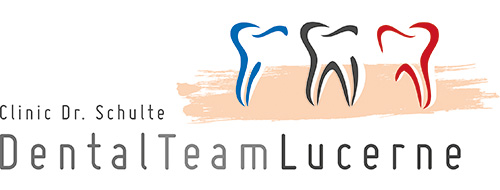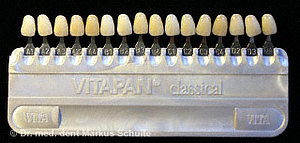Tooth Whitening (Bleaching): How to get beautiful white teeth
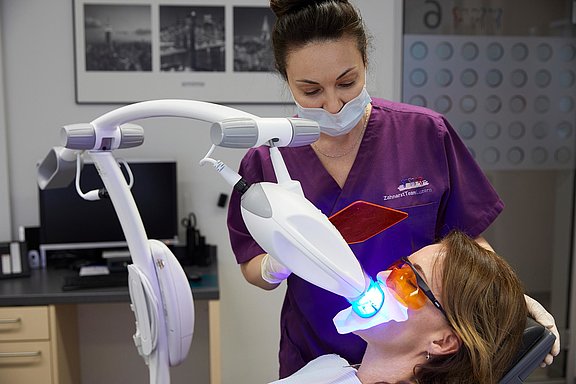
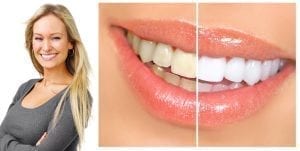
While in advertising and television we are constantly faced with gleaming white smiles, many “normal” people suffer from their yellowish, discolored and unattractive teeth. In many cases, a tooth whitening which is also referred to as bleaching, can help.
In this chapter we provide complete information about the various methods of teeth whitening with their advantages and disadvantages.
Read or print a complete article on one page: Tooth Whitening (Bleaching)
If you are interested in specific topics or if you want to read the chapter in sections, please choose from the following bullet points:
Why do teeth discolour or yellow?
- Individual tooth colour: Everybody has his innate tooth shade which can be brighter or darker.
- Ageing: teeth darken with age.
- Natural enamel deficiencies.
- Taking certain antibiotics (Tetracycline) in early childhood during the development phase of your teeth.
- Dental fluorosis through overdose of fluoride.
- Dead pulp or root canal treatment.
- Pigmentation from food or drink such as tea, coffee, red wine, and tobacco.
What bleaching techniques are available today?
- Rapid Bleaching (Power Bleaching, In-Office Bleaching) in the dental office. This technique produces a strong whitening effect within a short treatment time (ca. 90 minutes). It should only be performed by a dentist or an experienced dental hygienist.

Left: In-Office-Bleaching
Middle/Right: tray for home bleaching
- Home Bleaching carried out by the patient at home. With the home bleaching method, the patient wears at night (or for 2-3 hours during the day) a made-to-measure, transparent bleaching tray filled with bleaching gel. The teeth are gradually lightened with regular use of the trays. However, during home bleaching sometimes sensitive teeth and gum irritation can occur. Regular follow-up by the dentist is therefore recommended.
Furthermore, bleaching methods divide into the following categories:
- External Bleaching (surface bleaching) of vital teeth. This is the usual bleaching method in which the whitening paste is applied from the outside to the teeth.
- Internal Bleaching (bleaching from the inside) of dead (devitalised) teeth.
The Philips ZOOM® Method: White teeth in 90 minutes
In our office, we have chosen the effective and gentle ZOOM® system, giving good and long-lasting results in just 60 minutes treatment time (90 minutes including preparation).
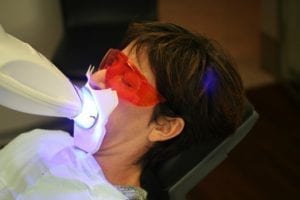
ZOOM® is a global market leader in tooth whitening. This system has seen over 1’000’000 successful applications so far. Our favourable experience prompted us to offer this method to our patients.
How does tooth whitening with ZOOM® work?
Firstly, the teeth are professionally cleaned and scaled. The gums are then coated with a protective lacquer, leaving just the teeth free. Following this, the light-activated bleaching gel is applied to the front surface of the teeth. The special ZOOM® lamp is positioned directly in front of the patient’s mouth, exposing the teeth to intense light for 20 minutes. During this time, the patient must wear protective goggles. This special light source emits almost no heat radiation during treatment. The procedure is repeated twice more, each time with fresh bleaching gel, making the total treatment time 60 minutes. After treatment, the protective lacquer is removed from the gums and any remaining bleaching gel washed away.
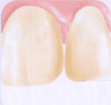
The whitening gel contains 25 % carbamide peroxide. This ingredient has been proven for over 20 years to be a safe and effective tooth whitener. It liberates hydrogen peroxide, which penetrates into the tooth splitting the color pigments by oxidation into colorless compounds . Special light activators are activated by the ZOOM lamp and enhance the whitening effect of the bleaching gel .
Detailed scientific information on the effectiveness and safety of the ZOOM teeth whitening can be found here ( pdf file, 2.1 MB)
Click here to see the video film the sequence of a ZOOM® treatment.
Click here to see the video film the sequence of a ZOOM® treatment.
What must be considered after tooth whitening?
In the first 24 hours after treatment, the enamel is somewhat rough and porous and can therefore easier takes on colors . Therefore, one should not smoke on the first day after bleaching and avoid highly coloured foods and beverages (eg beetroot, curry, berries, red wine, tea) . After 24 hours, the enamel is remineralised from the saliva getting smooth and resilient as ever and there are no more restrictions .
What are the advantages of ZOOM® tooth whitening?
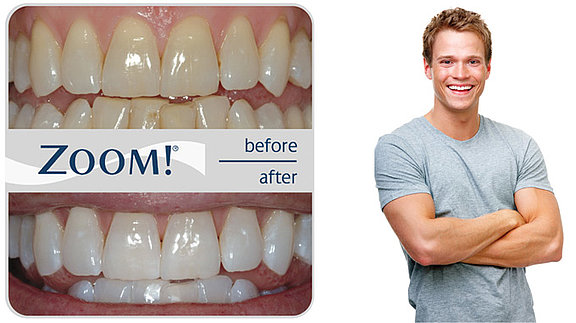
- This is a very effective bleaching method that brings about a whitening effect of eight shades of the Vitapan shade guide in only 60 minutes exposure time.
- ZOOM® bleaching is clinically tried, tested, and proved harmless.
- The special light-activated formula means ZOOM® is effective using only 25% active agent, whereas most other power bleaching substances use 35% bleaching gel thus being more aggressive.
- This means fewer unpleasant side effects such as hypersensitive tooth necks.
Case report from our clinic
This 17-year-old patient was unhappy with her yellowish teeth and desired a whitening by means of the ZOOM method.
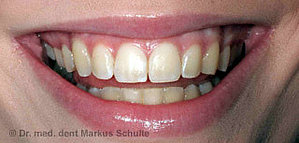
First, the gums are covered with a white protective varnish, then the whitening gel is applied to the teeth.
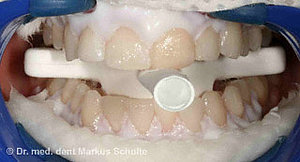
During the whitening procedure of 3 x 20 minutes the patients bites on a plastic block so that the activating light of the ZOOM lamp can reach all the tooth surfaces. Listening to music on headphones can help relax.
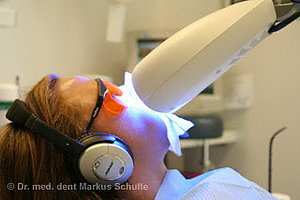
After the bleaching, much to the joy of our patient, her teeth appear remarkably brighter.
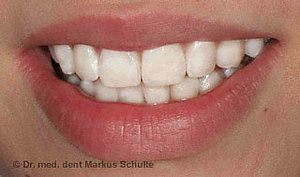
Does bleaching damage the teeth?
Scientific studies unanimously prove that bleaching under a dentist’s supervision causes no long-term damage or loss of substance to either teeth or gums. At the most, there may be increased sensitivity of the tooth necks, which subsides after treatment. This mostly applies to periodontitis patients with gingival regression and exposed roots.
Home bleaching performed without dentist’s control can however cause side effects: painful, long-lasting tooth hypersensitivity is not uncommon and sometimes leads to the discontinuation of the procedure by the patient. The whitening tray can also sometimes bring on inflammation of the gums. Not to be underestimated is also the risk of over-bleaching. If bleached too long at home or applied a too strong whitening gel, the incisors can become transparent and let shine through the dark mouth cavity. An unaesthetic bluish-black transparence is then the result and this effect unfortunately is irreversible, ie. it cannot be undone.
How long does the bleaching effect last?
Depending on the tooth type and patient behavior (smoking, drinking tea, etc.) the effect of tooth whitening usually lasts from two to four years. Then the bleaching can be repeated without any problem.
After the ZOOM in-office-whitening our patients receive a pair of customized bleaching trays for the home bleaching. So they can maintain easily and without additional expense the result obtained with occasional home bleaching.
Internal bleaching for dead (devital) teeth
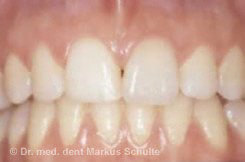
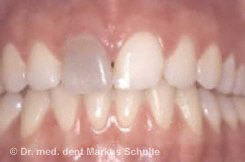
Devitalised right incisor before and after internal bleaching
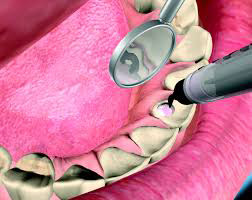
Devitalised and root canal treated teeth have a tendency to discolour after some time and take on a darker (browner) shade caused by the products of decomposition. This leads to a loss of aesthetics in the anterior region. Internal bleaching is the cure for this problem. This is performed by opening the devital tooth (from the backside, in this way not visible) and applying a special bleaching agent. The opening is then sealed with a temporary filling. This procedure takes about ten minutes and is repeated every three to five days until the desired shade is achieved. The bleaching effect lasts for several years and often saves the tooth from crowning.
Are all teeth suitable for bleaching?
Only natural teeth can be whitened, not foreign materials such as resin or ceramic. Smaller composite fillings usually are not a problem, adapting well to the surrounding colour. Large front tooth fillings or crowns can appear somewhat darker in comparison to the whitened adjecent teeth. Yellow or brownish teeth with uniform (homogeneous) colour are particularly suitable for whitening whereas the visible effect is less striking with grey dicolourations. Streaky or mottled teeth will become brighter but maintain their irregular colour pattern. Here sometimes an additional microabrasion can be indicated.
If your teeth are very transparent (thin enamel) caution is mandatory. An over-bleaching would even increase this transparency of the teeth letting shine through the dark oral cavity with an unfavourable aesthetic outcome. For this reason, the whitending procedure should be performed only by trained staff.
Who should avoid tooth bleaching?
During pregnancy or in the presence of severe systemic diseases no tooth whitening should be performed.
How much does teeth whitening cost?
For CHF 600.- we offer a professional ZOOM whitening of all teeth.
Moreover, we offer our patients an advantageous combined bleaching package consisting of:
- A complete teeth whitening in our practice with the Philips ZOOM technique.
- Moreover, you will receive a pair of bleaching trays for home bleaching. So you can comfortably rewhiten your teeth from time to time at home and keep the result of the bleaching over many years in an inexpensive way.
- This combined whitening package (ZOOM + home bleaching) is available for SFR 800.-
- In addition comes, if necessary or desired, a brief examination and tooth cleaning. Whitening is most effective on clean, tartar-free teeth.
The sole home bleaching is less expensive (about SFR 650.-) but not routinely recommended as for the reasons given above.
The charge for whitening a discolored non-vital (dead) tooth by internal bleaching can vary from SFR 300.- to SFR 500.-, depending on the number of sessions necessary. In addition, a filling must be placed to close the tooth.
Do you want to convert the SFR Rates ( Swiss Franc ) in EUROS or other currencies? Use the online currency converter.
Microabrasion against mottled teeth
Dark or white spots in the enamel are often the result of a disturbed tooth development in childhood and may significantly affect dental aesthetics. Tooth whitening alone will be of little use since the spots will get brighter, but not less disruptive. Microabrasion of the tooth enamel can provide remedy: On the mottled tooth a special paste (eg Opalustre) is applied , containing an acid and fine abrasive substances. This paste is briefly massaged into the enamel and then rinsed out with water. In this way, a very thin layer (about one tenth of a millimeter) of enamel and the discoloration therein is gently removed . In some cases, the micro-abrasion can be combined with a bleaching.

Extremely strong tooth discolorations (enamel dysplasia) which can not sufficiently be rectified by means of bleaching or micro abrasion, may require a coverage of the tooth with a ceramic veneer.
Dental Aesthetics
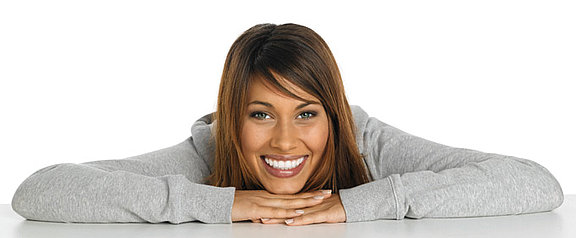
The methods for tooth whitening described above are considered a part of Aesthetic Dentistry: Further information on Dental Aesthetics.
Internal Bleaching für tote Zähne


Wurzeltoter rechter Schneidezahn vor und nach Internal Bleaching
